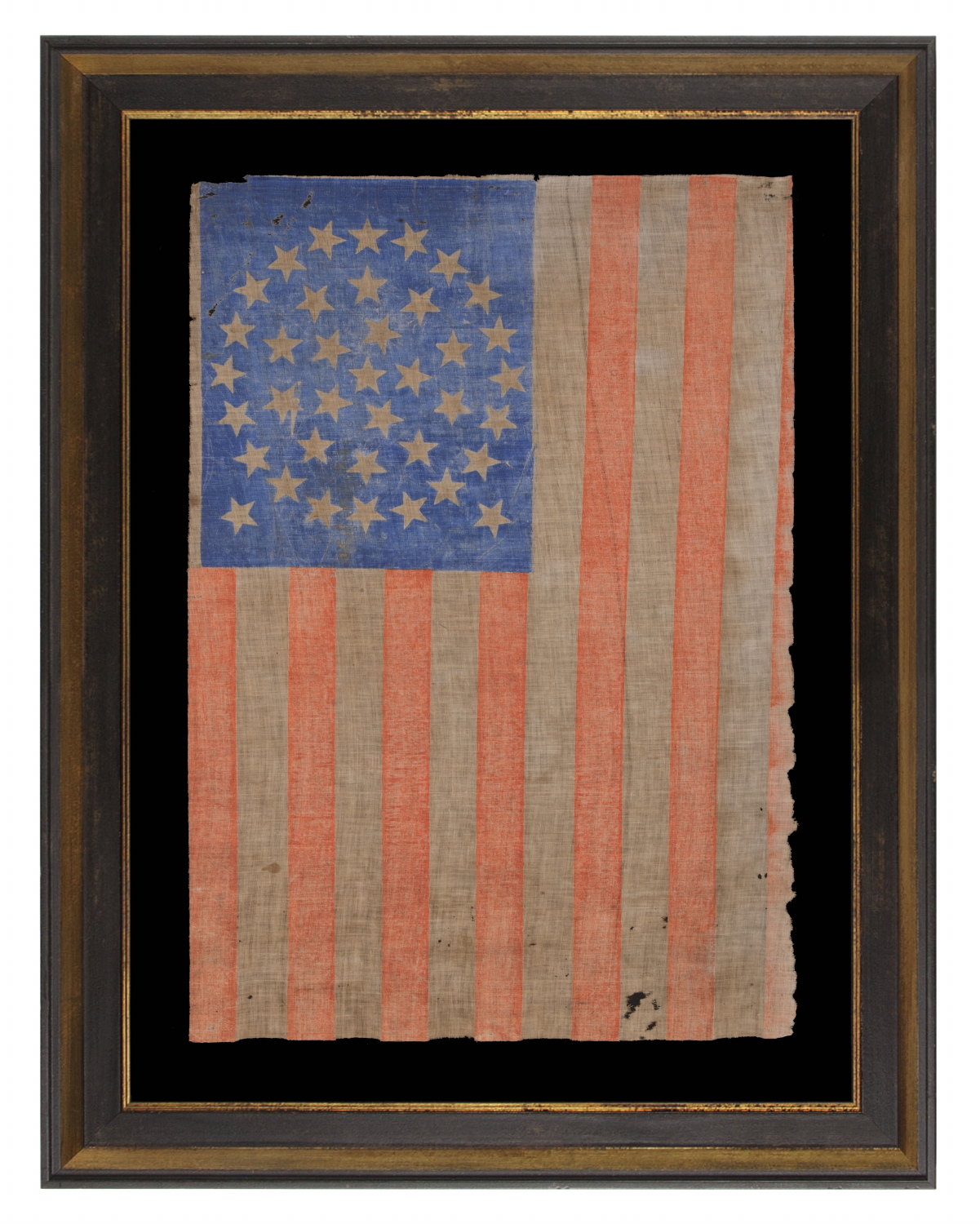
| |
38 STAR FLAG WITH A TRIPLE-WREATH CONFIGURATION AND 2 OUTLIERS, ON AN ANTIQUE AMERICAN PARADE FLAG WITH RICH, CORNFLOWER BLUE COLORATION AND ENDEARING WEAR, 1876-1889, COLORADO STATEHOOD |
|
| Available: |
Sold |
| Frame Size (H x L): |
Approx. 45" x 34.5" |
| Flag Size (H x L): |
32.5" x 22" |
|
| Description....: |
|
38 star American parade flag, block-printed by hand on coarse, glazed cotton. The stars are arranged in a triple-wreath form of the medallion configuration, with a single center star and two stars flanking outside the basic pattern toward the fly end. Most circular medallion patterns exhibit four flanking stars beyond the consecutive wreaths, one in each corner. The inclusion of only two was intentional, allowing for the easy addition of two more stars. Flag-makers knew that more Western Territories were soon to be added and eagerly anticipated their arrival. Use of fewer than four outliers was popular in 38 star parade flags, but is rarely encountered in other star counts.
Note the rich, cornflower blue canton and how it contrasts with the stripes. Most parade flags in this star count have red stripes that lean heavily toward orange, with a vibrant, chromatic luster, as-is the case here. This was common across printed flags produced between the 1850's and the 38 star period, phasing out in the last decade of the 19th century. Also note how the wear and patina contribute to an endearing presentation, with almost modernistic qualities.
Colorado became the 38th state on August 1st, 1876. This was the year of our nation’s 100-year anniversary of independence. Per the Third Flag Act of 1818, stars were not officially added until the 4th of July following a state's addition. For this reason, 37 was the official star count for the American flag in 1876. Flag-making was a competitive venture, however, and few flag-makers would have been continuing to produce 37 star flags when their competitors were making 38’s. It is for this reason that 38 and 13 stars (to represent the original 13 colonies) are more often seen at the Centennial International Exposition, the six-month long World’s Fair held in Philadelphia in honor of the event. Some flag-makers would have been adding a star for the 38th state even before it entered the Union, in the early part of 1876 or even prior. In fact, many makers of parade flags were actually producing 39 star flags, in hopeful anticipation of the addition of two more Western Territories instead of one. But the 39th state would not join the Union for another 13 years, when the Dakota Territory entered as two states on the same day. The 38 star flag became official on July 4th, 1877 and was generally used until the addition of the Dakotas in 1889.
President Ulysses S. Grant was in office when the first 38 star flags would have appeared. The list of presidents serving during the period when the 38 star flag was actually official include Rutherford B. Hayes, James Garfield, Chester Arthur, Grover Cleveland, and Benjamin Harrison.
Mounting: The flag has been placed in its correct vertical position, with its canton in the upper left. It was mounted and framed within our own conservation department, which is led by expert trained staff. We take great care in the mounting and preservation of flags and have framed thousands of examples; more than anyone worldwide.
The black-painted, hand-gilded and distressed molding is Italian. The glazing is U.V. protective acrylic. Feel free to contact us for more details.
Condition: There is modest to moderate fading throughout, accompanied by modest to moderate foxing and soiling. There are minor holes and losses along the hoist end, where the flag was once affixed to its original staff. There is a scattering of tiny holes in the upper, hoist-end corner of the canton, as well as towards the fly end in the white stripes, accompanied by a modest hole at the end of the 5th white stripe. There is what appears to be some rust spotting in the canton, in a lateral line extending inward from the fly end, just above center, running just into the second ring of stars. The printing is slightly askew, most prominent in the last stripe, which is triangular, due to the way that it was printed and trimmed. This is jagged along the edge, either from use or from the fabric having been torn while still on the bolt. Many of my clients prefer early flags to show their age and history of use. |
|
|
|
| Collector Level: |
Intermediate-Level Collectors and Special Gifts |
|
| Flag Type: |
Parade flag |
|
| Star Count: |
38 |
|
| Earliest Date of Origin: |
1876 |
|
| Latest Date of Origin: |
1889 |
|
| State/Affiliation: |
Colorado |
|
| War Association: |
1866-1890 Indian Wars |
|
| Price: |
SOLD |
|
| |
Views: 1406 |
|
|
|

